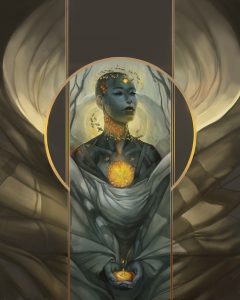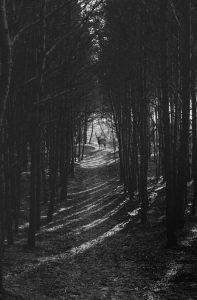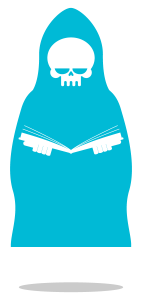 Even as insects buzz around her head, the woman is serene. The insects come from within, producing a rich honey that courses under her skin. The liquid gold warms and fuels. Magic and peace run through her veins. The cover art for July is a reprint you might have seen before–it was previously nominated for a Chesley Award for Best Magazine Art. The rich yellow hues are hard to forget.
Even as insects buzz around her head, the woman is serene. The insects come from within, producing a rich honey that courses under her skin. The liquid gold warms and fuels. Magic and peace run through her veins. The cover art for July is a reprint you might have seen before–it was previously nominated for a Chesley Award for Best Magazine Art. The rich yellow hues are hard to forget.
For the past eight years, Julie Dillon has cultivated an award-winning style. It’s easy to understand why she won Hugo Awards in 2014, 2016, and 2017. Her art is brightly coloured, almost glowing. Yellows and blues dominate. There’s always a centralized figure, drawing the eye. Julie creates characters that want you to look at them. They’re powerful, whether they’re traveling with family or launching into battle.
There’s the expectation that winning a Hugo means hitting the bigtime and it’s all laurel-resting from thereon out. After winning three Hugos, one can imagine Julie making her art aboard her hovercraft on her private island. Expectations and reality are always hard hitters for creatives. When she won her first award in 2014, Julie thought she could finally breathe easy.
I really thought that it would be a big boost to my career, and that it was a signal that I would finally have some kind of stability. Oddly enough, though, my freelance work dried up almost immediately after my first win.
Imposter syndrome doesn’t just affect creatives, it also affects buyers. Something changes with the public mindset once writers and artists get critical acclaim. Fear and insecurity make people shy to commission new work or pay for reprints. There’s the immediate thought that the artist is now too busy, too expensive. It’s a mindset that even our editors are grappling with. Every time we email an artist or author for a reprint, we have a paralyzing thought that our request will be laughed at. After all, they’re the award-winner and we’re just the upstart.
After the awards slump, Julie never stopped hustling and learning. She leveraged her talent and created covers for Tor, Angry Robot, and Penguin Books. She challenged herself to keep up with the evolving art and publishing markets. She published two art books called Imagined Realms, where she created original art inspired by sci-fi and fantasy themes. Although she had planned for a series, as a freelancer Julie could only focus on one long-term project for so long, and ended up shelving the series after two gorgeous books.
I used to naively think that there was some magical point in my career where I would have finally “made it” and I could relax, assured in my financial stability, but I’ve found that that doesn’t seem to be the case. From talking with other artists, it sounds like it’s always feast or famine.
Though Julie’s art is lush and fantastical, she draws from small, personal experiences to inspire her. She stresses that inspiration doesn’t need to be life-changingly spectacular. Julie uses small moments to “find beauty in the everyday and ordinary, to not take things for granted and to try to find magic even when things seem ugly and grey and dull around you.”
In a world that sometimes feels overwhelmingly grey, it’s an important lesson to take to heart. The beauty and positivity that Julie can wring out of the everyday is felt in her work. There’s power, emotion, and colour–all of which we should be harnessing everyday.
Even the most fantastical art has roots in reality. There is usually almost always some real life reference I can utilize, it’s just matter of exaggerating it and transforming it.
If you want more information about Julie and her work, check out her online portfolio at https://www.juliedillonart.com/ Julie will be launching a Kickstarter from July 17th to August 23rd for a new artbook that will cover her 20-year career. Check out her twitter, @juliedillon, for updates.
Full QA with Julie Dillon
Tell me a bit about yourself. Who are you, where did you grow up?
I grew up in Northern California, where there are lots of rolling hills and oak trees, but not much else. I have drawn and painted for my entire life, but never took art seriously until my early 20s, because I had always thought that art was a hobby, not a viable career. I was terrified of the prospect of student loans, so I only attended the schooling I could afford without loans, which meant going to local colleges, and taking one class at a time an art school. I might have had a more robust career if I had attended an art school fulltime, but not having the student loans has afforded me a lot more financial flexibility.
You mention on your website that you love finding “magic in the world around me.” Any unusual or memorable instances that you found surprisingly inspiring?
Well, nothing unusual. I mean, that’s the whole point, trying to find beauty in the everyday and ordinary, to not take things for granted and to try to find magic even when things seem ugly and grey and dull around you. It doesn’t have to be a big spectacular thing. Sometimes I’m struck by the way the sunlight hits the steam rising from one’s coffee mug, or how tree leaves glow in the afternoon light, or how birdsong can completely transform the atmosphere of a place. The character of a stranger riding on the bus, the transformative power of rain and water on landscapes. These things don’t always make their way into my work in a literal sense, but they inform my aesthetics and the subject matter that I gravitate towards.
What gets you excited to get back to work when you’re feeling blocked or tired or uninspired?
Finishing up a work project and getting to start a new personal project usually gets me excited to create again. If I’m too burned out during or after a work project, I will go hiking out in nature and/or listen to music that resonates with me, which seems to help me reboot my system somewhat. I have a good enough work ethic to get things done and meet my deadlines no matter how uninspired I feel, but feeling worn out and uninspired is no way to go through life, so I make sure to tend to my inner life as often as I can.
As a someone who draws fantastical art, what type of research do you do before working on a new piece?
Even the most fantastical art has roots in reality. There is usually almost always some real life reference I can utilize, it’s just matter of exaggerating it and transforming it. I can utilize pictures of crocodiles, lizards, elephants, etc to help me figure out how I want a dragon to look, for example. I have huge folders of reference photos of landscapes, plants, clothing, textures, faces, and architecture to give me guidance on all stages of an illustration. The trick is trying to figure out what exactly you need as reference, and how to go about finding it.
What was that turning point for becoming a professional artist in 2006? Any advice for artists (and creatives of all sorts) that are ready to give up the day job and make their passion their career? What keeps you learning/growing/challenging yourself?
The turning point is that I thought I was ready. I wasn’t ready, but I jumped in anyway. I was unsuccessful for a long time, but I kept at it and clawed my way up from the bottom, taking whatever work I could find to build my portfolio and attract new clients. I keep challenging myself in part because I want to, and in part because I have to if I want to stay competitive and continue to find work. The art and publishing markets are always evolving, and if I stand still I risk being left behind. I used to naively think that there was some magical point in my career where I would have finally “made it” and I could relax, assured in my financial stability, but I’ve found that that doesn’t seem to be the case. From talking with other artists, it sounds like it’s always feast or famine.
You’ve developed an amazing portfolio, often working with notable presses like Tor, Angry Robot, and Penguin Books. Why have you decided to remain in freelancing?
I remain in freelancing because that’s the only way I currently have to pay my bills. I don’t have the skillset to work in games or film or be hired fulltime anywhere, so I keep freelancing. I have been working hard these past few years to figure out how to branch out into other areas to give me a little more stability (through fine art, licensing, POD sites etc), but building any new venture takes time.
Your cover art is fantastical and often very detailed. How do you create the stories behind the art? Which comes first, the concept or the execution?
In the case of cover art, I’m always given the stories first to work from. But for my own work, a lot of times the story evolves as I work on the piece. I’ll have an idea for a scene, and the narrative develops as I sketch.
Why have you chosen Digital Art as your medium? Is it a style that you came across in University or has it always been a part of you?
Digital art is something I just kind of fell into. I had done mostly color pencil and pastels growing up, but digital art was popular online in the late 90s and early 2000s, so I bought a cheap tablet and jumped on the bandwagon. I liked that with digital painting, it was easy to apply solid areas color, and I didn’t have to constantly buy supplies. Over the years working digitally has helped a lot with maintaining a quick workflow. My college did not help whatsoever, they were very much against illustration and digital art in general; they had a strict “fine art/abstract art only” attitude, unfortunately.
You won Hugo award in 2014, 2015 and 2017. Plus you were nominated in 2013. For many new artists and writers, getting a Hugo seems like a finishing move. How did you react when you won in back in 2014? Did your art change at all?
I was incredibly excited, I really thought that it would be a big boost to my career, and that it was a signal that I would finally have some kind of stability. Oddly enough, though, my freelance work dried up almost immediately after my first win. I’m in an odd place now, where on the one hand it’s a huge honor, but on the other hand, I’m earning less money every year despite working harder and harder. I’m not sure what to make of that.
In 2014, Tor published an amazing overview of your artwork. The article specifically calls out your intentional use of colour. There’s often a yellow hue (sometimes subtle) that catches the reader’s eye — is there a reason you find yourself drawn to the colour yellow?
Yellows and oranges just have a magical warmth to them, I feel. They evoke a golden afternoon light and a sense of fullness that feels nice and that I keep gravitating towards. A lot of times I start with a slightly different color scheme, but then I start messing around with hard light blending modes in photoshop, and I realize I like the illustration a lot more with more honeyed yellow glow in the background.
You published two art books called Imagined Realms. How did you develop the concepts for the artwork? If the series had continued, how would you have developed the themes?
I liked the idea of being able to do projects that were 100% my own work, and I thought the best way to go about that was to have loose genre themes per book. The first book was fantasy, and the second was scifi. I thought about doing a magical realism/ urban fantasy book, and then cycling back through fantasy and scifi, but ultimately the books took too much time to put together to be profitable as a long term project. I think that if I did take it up again, I would run a patreon concurrently to help support myself while I work on the new art.
You’re on Twitter, Instagram, Deviant Art, and Red Bubble. What do you find are the benefits of social media? Are there any downsides to maintaining an online presence as an artist?
Social media is pretty much only way I’ve been able to get any freelance work at all. Art directors, publishers, and potential clients are on social media, and are more likely to come across your work the more active you are. Of course, you have to be careful you don’t present yourself in a way that would make the people you want to work with decide to not hire you. I tend to use different social media for different purposes, keeping some as mostly art only accounts, and some where I talk a bit more. I tend to lean on the quieter side on anything that is public, though, just out of habit.
Do you have anything you’d like to promote to our readers?
Yes! I will be launching a kickstarter from July 17th to August 23rd for “Daydreamer’s Journey,” a 200+ page art book featuring art from the past 20+ years of my career. Aside from my main portfolio pieces, there will be sketches, studies, unfinished works, and commissioned art that I have never posted online before. Please check it out if interested. 🙂 Updates will be posted on my twitter account, @juliedillon.






